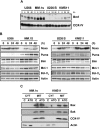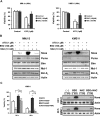BH3-only proteins Noxa, Bmf, and Bim are necessary for arsenic trioxide-induced cell death in myeloma
- PMID: 18354037
- PMCID: PMC2384139
- DOI: 10.1182/blood-2007-10-116889
BH3-only proteins Noxa, Bmf, and Bim are necessary for arsenic trioxide-induced cell death in myeloma
Abstract
The use of arsenic trioxide (ATO) to treat multiple myeloma (MM) is supported by preclinical studies as well as several phase 2 studies, but the precise mechanism(s) of action of ATO has not been completely elucidated. We used gene expression profiling to determine the regulation of apoptosis-related genes by ATO in 4 MM cell lines and then focused on Bcl-2 family genes. ATO induced up-regulation of 3 proapoptotic BH3-only proteins (Noxa, Bmf, and Puma) and down-regulation of 2 antiapoptotic proteins Mcl-1 and Bcl-X(L). Coimmunoprecipitation demonstrated that Noxa and Puma bind Mcl-1 to release Bak and Bim within 6 hours of ATO addition. Bak and Bim are also released from Bcl-X(L). Silencing of Bmf, Noxa, and Bim significantly protected cells from ATO-induced apoptosis, while Puma silencing had no effect. Consistent with a role for Noxa inhibition of Mcl-1, the Bad-mimetic ABT-737 synergized with ATO in the killing of 2 MM lines. Finally, Noxa expression was enhanced by GSH depletion and inhibited by increasing GSH levels in the cells. Understanding the pattern of BH3-only protein response should aid in the rational design of arsenic-containing regimens.
Figures







Similar articles
-
Synergistic induction of apoptosis by p53-inducible Bcl-2 family proteins Noxa and Puma.J Nippon Med Sch. 2007 Apr;74(2):148-57. doi: 10.1272/jnms.74.148. J Nippon Med Sch. 2007. PMID: 17507791
-
Darinaparsin induces a unique cellular response and is active in an arsenic trioxide-resistant myeloma cell line.Mol Cancer Ther. 2009 May;8(5):1197-206. doi: 10.1158/1535-7163.MCT-08-1072. Epub 2009 May 5. Mol Cancer Ther. 2009. PMID: 19417148 Free PMC article.
-
BIM-mediated AKT phosphorylation is a key modulator of arsenic trioxide-induced apoptosis in cisplatin-sensitive and -resistant ovarian cancer cells.PLoS One. 2011;6(5):e20586. doi: 10.1371/journal.pone.0020586. Epub 2011 May 31. PLoS One. 2011. PMID: 21655183 Free PMC article.
-
Bim and Bmf in tissue homeostasis and malignant disease.Oncogene. 2008 Dec;27 Suppl 1(Suppl 1):S41-52. doi: 10.1038/onc.2009.42. Oncogene. 2008. PMID: 19641506 Free PMC article. Review.
-
The Bcl-2 apoptotic switch in cancer development and therapy.Oncogene. 2007 Feb 26;26(9):1324-37. doi: 10.1038/sj.onc.1210220. Oncogene. 2007. PMID: 17322918 Free PMC article. Review.
Cited by
-
Bone marrow microenvironment-derived signals induce Mcl-1 dependence in multiple myeloma.Blood. 2017 Apr 6;129(14):1969-1979. doi: 10.1182/blood-2016-10-745059. Epub 2017 Feb 1. Blood. 2017. PMID: 28151428 Free PMC article.
-
PUMA, a potent killer with or without p53.Oncogene. 2008 Dec;27 Suppl 1(Suppl 1):S71-83. doi: 10.1038/onc.2009.45. Oncogene. 2008. PMID: 19641508 Free PMC article. Review.
-
Bcl2 family proteins in carcinogenesis and the treatment of cancer.Apoptosis. 2009 Apr;14(4):584-96. doi: 10.1007/s10495-008-0300-z. Apoptosis. 2009. PMID: 19156528 Free PMC article.
-
Functional cooperation of the proapoptotic Bcl2 family proteins Bmf and Bim in vivo.Mol Cell Biol. 2010 Jan;30(1):98-105. doi: 10.1128/MCB.01155-09. Mol Cell Biol. 2010. PMID: 19841067 Free PMC article.
-
Synaptoprotection in Perinatal Asphyxia: An Experimental Approach.Front Synaptic Neurosci. 2020 Sep 23;12:35. doi: 10.3389/fnsyn.2020.00035. eCollection 2020. Front Synaptic Neurosci. 2020. PMID: 33071771 Free PMC article.
References
-
- Jemal A, Siegel R, Ward E, et al. Cancer statistics, 2006. CA Cancer J Clin. 2006;56:106–130. - PubMed
-
- Hideshima T, Leif Bergsagel P, Kuehl WM, Anderson KC. Advances in biology of multiple myeloma: clinical applications. Blood. 2004;104:607–618. - PubMed
-
- Rousselot P, Labaume S, Marolleau JP, et al. Arsenic trioxide and melarsoprol induce apoptosis in plasma cell lines and in plasma cells from myeloma patients. Cancer Res. 1999;59:1041–1048. - PubMed
-
- Park WH, Seol JG, Kim ES, et al. Arsenic trioxide-mediated growth inhibition in MC/CAR myeloma cells via cell cycle arrest in association with induction of cyclin-dependent kinase inhibitor, p21, and apoptosis. Cancer Res. 2000;60:3065–3071. - PubMed
-
- Grad JM, Bahlis NJ, Reis I, Oshiro MM, Dalton WS, Boise LH. Ascorbic acid enhances arsenic trioxide-induced cytotoxicity in multiple myeloma cells. Blood. 2001;98:805–813. - PubMed
Publication types
MeSH terms
Substances
Grants and funding
LinkOut - more resources
Full Text Sources
Medical
Research Materials

